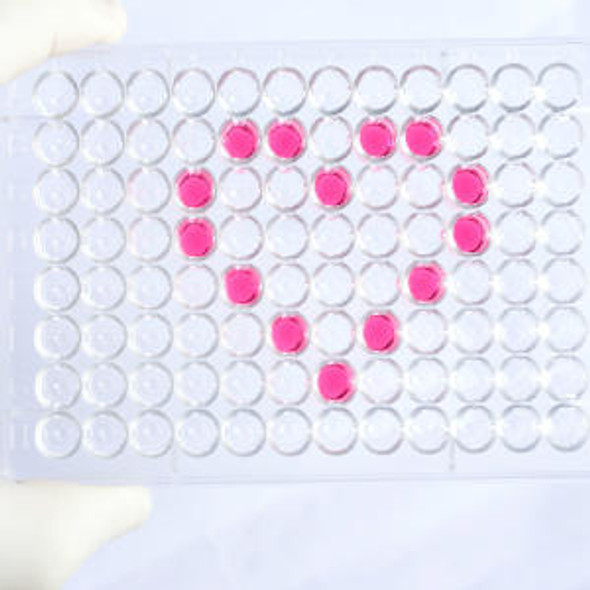Human Immunology ELISA Kits 2
Human ANXA1(Annexin A1) ELISA Kit (HUES03491)
- SKU:
- HUES03491
- Product Type:
- ELISA Kit
- Size:
- 96 Assays
- Uniprot:
- P04083
- Sensitivity:
- 0.19ng/mL
- Range:
- 0.31-20ng/mL
- ELISA Type:
- Sandwich
- Reactivity:
- Human
- Sample Type:
- Serum, plasma and other biological fluids
- Research Area:
- Immunology
Description
| Assay type: | Sandwich |
| Format: | 96T |
| Assay time: | 4.5h |
| Reactivity: | Human |
| Detection Method: | Colormetric |
| Detection Range: | 0.31-20 ng/mL |
| Sensitivity: | 0.19 ng/mL |
| Sample Volume Required Per Well: | 100µL |
| Sample Type: | Serum, plasma and other biological fluids |
| Specificity: | This kit recognizes Human ANXA1 in samples. No significant cross-reactivity or interference between Human ANXA1 and analogues was observed. |
This ELISA kit uses Sandwich-ELISA as the method. The micro ELISA plate provided in this kit has been pre-coated with an antibody specific to Human ANXA1. Standards or samples are added to the appropriate micro ELISA plate wells and combined with the specific antibody. Then a biotinylated detection antibody specific for Human ANXA1 and Avidin-Horseradish Peroxidase (HRP) conjugate are added to each micro plate well successively and incubated. Free components are washed away. The substrate solution is added to each well. Only those wells that contain Human ANXA1, biotinylated detection antibody and Avidin-HRP conjugate will appear blue in color. The enzyme-substrate reaction is terminated by adding Stop Solution and the color turns yellow. The optical density (OD) is measured spectrophotometrically at a wavelength of 450 nm ± 2 nm. The OD value is proportional to the concentration of Human ANXA1. The concentration of Human ANXA1 in samples can be calculated by comparing the OD of the samples to the standard curve.
| UniProt Protein Function: | ANXA1: a calcium/phospholipid-binding protein with which promotes membrane fusion and is involved in endocytosis. Has anti-inflammatory properties and inhibits phospholipase A2 activity. Accumulates on internalized vesicles after EGF-stimulated endocytosis, suggesting that it may be required for a late stage in inward vesiculation. Phosphorylated by PKC, EGFR and Chak1. Phosphorylation results in loss of the inhibitory activity. Annexins are a family of structurally related proteins whose common property is calcium-dependent binding to phospholipids. There are at least ten different annexins in mammalian species. Annexins do not contain signal peptides, yet some annexins (A1, A2 and A5) appear to be secreted in a physiologically regulated fashion. |
| UniProt Protein Details: | Protein type:Lipid-binding; Calcium-binding Chromosomal Location of Human Ortholog: 9q21. 13 Cellular Component: apical plasma membrane; basolateral plasma membrane; cell surface; cornified envelope; cytoplasm; cytoplasmic vesicle membrane; early endosome membrane; endosome; extracellular region; extracellular space; extrinsic to external side of plasma membrane; extrinsic to membrane; focal adhesion; lateral plasma membrane; mast cell granule; mitochondrial membrane; nucleoplasm; nucleus; phagocytic cup; plasma membrane; protein complex; sarcolemma; vesicle Molecular Function:calcium ion binding; calcium-dependent phospholipid binding; calcium-dependent protein binding; double-stranded DNA-dependent ATPase activity; helicase activity; phospholipase A2 inhibitor activity; phospholipid binding; protein binding; protein binding, bridging; protein homodimerization activity; receptor binding; single-stranded DNA binding; single-stranded RNA binding; structural molecule activity Biological Process: actin cytoskeleton reorganization; adaptive immune response; alpha-beta T cell differentiation; arachidonic acid secretion; cell surface receptor linked signal transduction; DNA duplex unwinding; DNA strand renaturation; endocrine pancreas development; G-protein signaling, coupled to cyclic nucleotide second messenger; gliogenesis; inflammatory response; innate immune response; insulin secretion; keratinocyte differentiation; monocyte chemotaxis; muscle contraction; myoblast migration involved in skeletal muscle regeneration; negative regulation of apoptosis; negative regulation of exocytosis; negative regulation of T-helper 2 cell differentiation; neutrophil homeostasis; peptide cross-linking; phagocytosis; positive regulation of interleukin-2 production; positive regulation of neutrophil apoptosis; positive regulation of prostaglandin biosynthetic process; positive regulation of T cell proliferation; positive regulation of T-helper 1 cell differentiation; positive regulation of vesicle fusion; prostate gland development; regulation of cell shape; regulation of hormone secretion; regulation of inflammatory response; regulation of interleukin-1 production; regulation of leukocyte migration; response to drug; response to estradiol stimulus; response to peptide hormone stimulus; response to X-ray; signal transduction |
| NCBI Summary: | This gene encodes a membrane-localized protein that binds phospholipids. This protein inhibits phospholipase A2 and has anti-inflammatory activity. Loss of function or expression of this gene has been detected in multiple tumors. [provided by RefSeq, Dec 2014] |
| UniProt Code: | P04083 |
| NCBI GenInfo Identifier: | 113944 |
| NCBI Gene ID: | 301 |
| NCBI Accession: | P04083. 2 |
| UniProt Secondary Accession: | P04083,P10107, |
| UniProt Related Accession: | P04083 |
| Molecular Weight: | 38,714 Da |
| NCBI Full Name: | Annexin A1 |
| NCBI Synonym Full Names: | annexin A1 |
| NCBI Official Symbol: | ANXA1 |
| NCBI Official Synonym Symbols: | ANX1; LPC1 |
| NCBI Protein Information: | annexin A1 |
| UniProt Protein Name: | Annexin A1 |
| UniProt Synonym Protein Names: | Annexin I; Annexin-1; Calpactin II; Calpactin-2; Chromobindin-9; Lipocortin I |
| Protein Family: | Annexin |
| UniProt Gene Name: | ANXA1 |
| UniProt Entry Name: | ANXA1_HUMAN |
As the OD values of the standard curve may vary according to the conditions of the actual assay performance (e. g. operator, pipetting technique, washing technique or temperature effects), the operator should establish a standard curve for each test. Typical standard curve and data is provided below for reference only.
| Concentration (ng/mL) | O.D | Average | Corrected |
| 20 | 2.327 2.337 | 2.332 | 2.253 |
| 10 | 1.454 1.51 | 1.482 | 1.403 |
| 5 | 0.879 0.861 | 0.87 | 0.791 |
| 2.5 | 0.448 0.466 | 0.457 | 0.378 |
| 1.25 | 0.228 0.226 | 0.227 | 0.148 |
| 0.63 | 0.182 0.162 | 0.172 | 0.093 |
| 0.31 | 0.12 0.134 | 0.127 | 0.048 |
| 0 | 0.07 0.088 | 0.079 | -- |
Precision
Intra-assay Precision (Precision within an assay): 3 samples with low, mid range and high level Human ANXA1 were tested 20 times on one plate, respectively.
Inter-assay Precision (Precision between assays): 3 samples with low, mid range and high level Human ANXA1 were tested on 3 different plates, 20 replicates in each plate.
| Intra-assay Precision | Inter-assay Precision | |||||
| Sample | 1 | 2 | 3 | 1 | 2 | 3 |
| n | 20 | 20 | 20 | 20 | 20 | 20 |
| Mean (ng/mL) | 0.91 | 2.01 | 9.28 | 0.88 | 2.07 | 9.54 |
| Standard deviation | 0.06 | 0.09 | 0.47 | 0.05 | 0.10 | 0.51 |
| C V (%) | 6.59 | 4.48 | 5.06 | 5.68 | 4.83 | 5.35 |
Recovery
The recovery of Human ANXA1 spiked at three different levels in samples throughout the range of the assay was evaluated in various matrices.
| Sample Type | Range (%) | Average Recovery (%) |
| Serum (n=5) | 91-104 | 96 |
| EDTA plasma (n=5) | 91-108 | 99 |
| Cell culture media (n=5) | 94-107 | 101 |
Linearity
Samples were spiked with high concentrations of Human ANXA1 and diluted with Reference Standard & Sample Diluent to produce samples with values within the range of the assay.
| Serum (n=5) | EDTA plasma (n=5) | Cell culture media (n=5) | ||
| 1:2 | Range (%) | 89-100 | 93-110 | 97-110 |
| Average (%) | 95 | 100 | 104 | |
| 1:4 | Range (%) | 93-104 | 85-99 | 89-101 |
| Average (%) | 99 | 91 | 95 | |
| 1:8 | Range (%) | 90-102 | 80-93 | 83-93 |
| Average (%) | 97 | 87 | 88 | |
| 1:16 | Range (%) | 91-108 | 85-98 | 83-94 |
| Average (%) | 98 | 91 | 88 |
An unopened kit can be stored at 4°C for 1 month. If the kit is not used within 1 month, store the items separately according to the following conditions once the kit is received.
| Item | Specifications | Storage |
| Micro ELISA Plate(Dismountable) | 8 wells ×12 strips | -20°C, 6 months |
| Reference Standard | 2 vials | |
| Concentrated Biotinylated Detection Ab (100×) | 1 vial, 120 µL | |
| Concentrated HRP Conjugate (100×) | 1 vial, 120 µL | -20°C(shading light), 6 months |
| Reference Standard & Sample Diluent | 1 vial, 20 mL | 4°C, 6 months |
| Biotinylated Detection Ab Diluent | 1 vial, 14 mL | |
| HRP Conjugate Diluent | 1 vial, 14 mL | |
| Concentrated Wash Buffer (25×) | 1 vial, 30 mL | |
| Substrate Reagent | 1 vial, 10 mL | 4°C(shading light) |
| Stop Solution | 1 vial, 10 mL | 4°C |
| Plate Sealer | 5 pieces | |
| Product Description | 1 copy | |
| Certificate of Analysis | 1 copy |
- Set standard, test sample and control (zero) wells on the pre-coated plate and record theirpositions. It is recommended to measure each standard and sample in duplicate. Note: addall solutions to the bottom of the plate wells while avoiding contact with the well walls. Ensuresolutions do not foam when adding to the wells.
- Aliquot 100µl of standard solutions into the standard wells.
- Add 100µl of Sample / Standard dilution buffer into the control (zero) well.
- Add 100µl of properly diluted sample (serum, plasma, tissue homogenates and otherbiological fluids) into test sample wells.
- Cover the plate with the sealer provided in the kit and incubate for 90 min at 37°C.
- Aspirate the liquid from each well, do not wash. Immediately add 100µL of BiotinylatedDetection Ab working solution to each well. Cover the plate with a plate seal and gently mix. Incubate for 1 hour at 37°C.
- Aspirate or decant the solution from the plate and add 350µL of wash buffer to each welland incubate for 1-2 minutes at room temperature. Aspirate the solution from each well andclap the plate on absorbent filter paper to dry. Repeat this process 3 times. Note: a microplatewasher can be used in this step and other wash steps.
- Add 100µL of HRP Conjugate working solution to each well. Cover with a plate seal andincubate for 30 min at 37°C.
- Aspirate or decant the solution from each well. Repeat the wash process for five times asconducted in step 7.
- Add 90µL of Substrate Reagent to each well. Cover with a new plate seal and incubate forapproximately 15 min at 37°C. Protect the plate from light. Note: the reaction time can beshortened or extended according to the actual color change, but not by more than 30min.
- Add 50 µL of Stop Solution to each well. Note: Adding the stop solution should be done inthe same order as the substrate solution.
- Determine the optical density (OD value) of each well immediately with a microplate readerset at 450 nm.






